Whether you work for a SaaS business, an e-commerce business, an online publisher, or anything in between, one of the ‘golden rules’ of SEO is to update your content regularly to succeed online.
Content creation is not a ‘one-and-done’ thing. It’s an ever-evolving process that you need to stay on top of.
But how often should you update your website’s content? Is there a golden rule you need to follow? Do you need to update content every three months? Every six months? Every year?
In this article, we will answer that question and introduce some tools to help you find content that needs updating on your website.
How Often Should I Update My Website’s Content?
There is no set rule of thumb for updating or refreshing content. Some pieces that rely on fresh information (think price comparison sites) will naturally need to be updated more regularly. Other pages with ‘evergreen’ content might not need to be updated as much. That being said, a good rule to follow is to audit your content regularly to find good candidates for content updates and refreshes.
How to Find Pages that Need Content Updates: The Manual Way
Regularly updating your website’s content ensures it remains accurate and engaging. Here’s a straightforward process to identify content that may need a refresh. Be warned: It does take a significant amount of time, especially if you have a lot of content on your website!
Audit your Content
You should start by conducting a thorough content audit. This involves creating a catalog of all of the pages on your website and evaluating each piece based on factors like relevance, accuracy, engagement metrics (page views, time on page, engagement rate), and performance in the SERPs.
Check for Outdated Information
You also need to look for outdated information on your pages. This will include statistics, references to specific dates or events that have passed, and any content related to products, services, or technologies that have changed or been discontinued.
Analyze Performance Metrics
Tools like GA4 and Google Search Console can identify underperforming pages based on your metrics and KPIs. Low traffic, low engagement rates, or poor conversion rates can indicate content that needs improvement.
Review Rankings
You also need to analyze your website’s performance in search engines. Pages that have fallen in rankings or fail to target the right keywords should be prioritized for updates to improve visibility.
Monitor Competitor Websites
Keeping an eye on your competitor can help you identify gaps or areas where your content might be falling behind in freshness, depth, relevance, or overall quality.
How to Find Pages that Need Content Updates: The Quick Way
While the process above is comprehensive, it will take a lot of time, especially if you have a large website with many content pieces. Luckily, the Content Decay Report from SEOTesting offers a speedy way of finding content on your website that may be eligible for a content refresh.
Simply open up the Content Decay Report, and you will be greeted with a page looking like this:
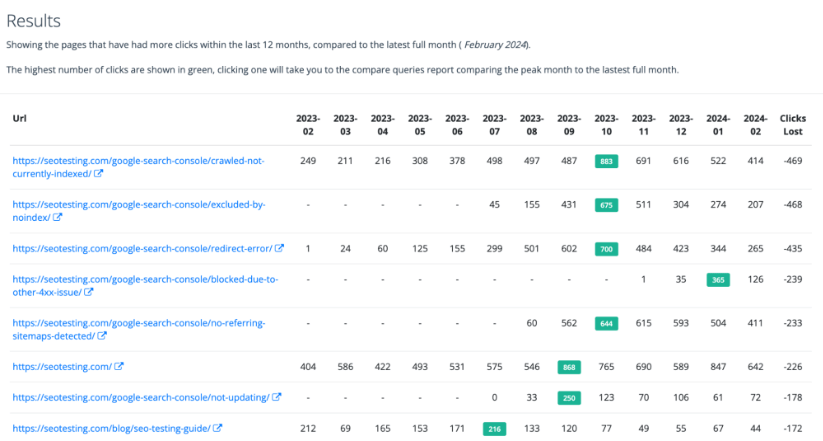
Using GSC data, this report takes all of your content pieces’ clicks in the last 12 months and compares it to the latest whole month. For the example of the screenshot above, this is February 2024.
The month each piece received the highest number of clicks is highlighted in green, and you can see on the right-hand side of the screen how many clicks the piece has lost since then. The report is ordered by the content that has lost the most clicks from its peak, so the articles at the top of this report potentially offer the best return if you can refresh the content and reclaim rankings.
The Content Decay report will help easily you spot pages ripe for a content update! Regarding the above report, our blog post on the ‘Excluded by Noindex’ report in GSC might be due to an update!

Another report that is useful in this situation is the ‘Low Quality Content’ report from SEOTesting. This report will scour your sitemap for pages with low numbers of clicks and impressions. This is a great way to quickly see pages on your website that may require an update.
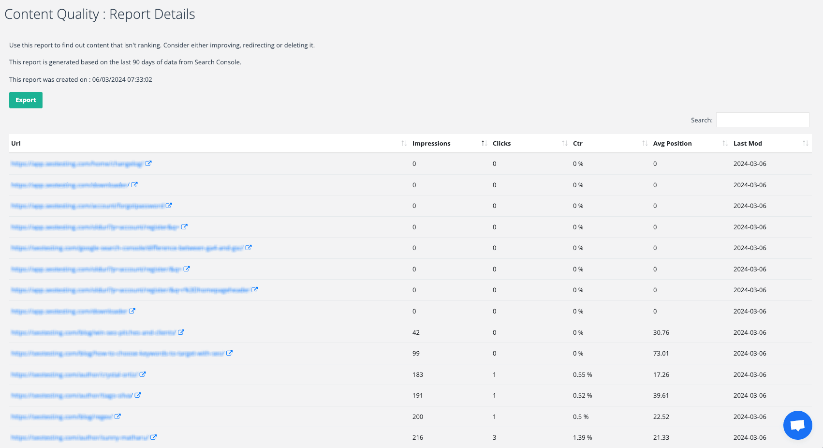
What is a Content Update?
A content update is, in essence, any change to a page or group of pages on your website. Whether this is simply adding a few internal links to a blog post, changing your Homepage’s ‘hero’ image, or completely changing how your website looks. Any change that you make to your website can be classed as a content update.
Naturally, there are many types of content updates. However, as an SEO, you must be aware of four main categories of content updates.
- Content refreshes.
- Website layout updates.
- CMS migrations.
- Website redesigns.
This next section will discuss each update type, why they’re essential, and what they typically look like. Of course, we will also include some example screenshots to help readers better understand these updates.
What is a Content Refresh?
A content refresh is an edit of existing content on your website. This kind of update can cover any page on your site, from articles to FAQ pages. Some content refreshes are small, involving internal link changes and minor text amendments. Some content updates can be much larger, changing most content to fit search intent better.
When done well, content refreshes can remarkably impact your organic website traffic! Here are the results of a single-page SEO test we conducted following a comprehensive content refresh of our article on keyword cannibalization:
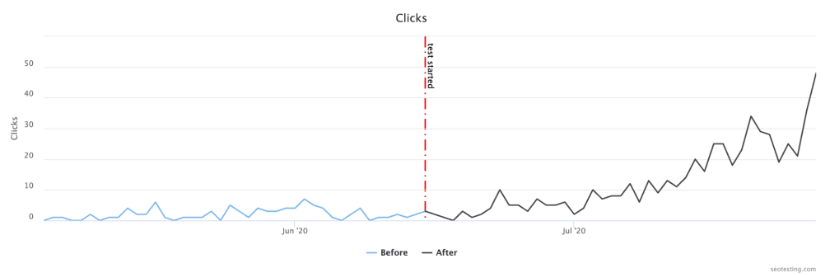
The above screenshot shows the impact on organic clicks following the content refresh.
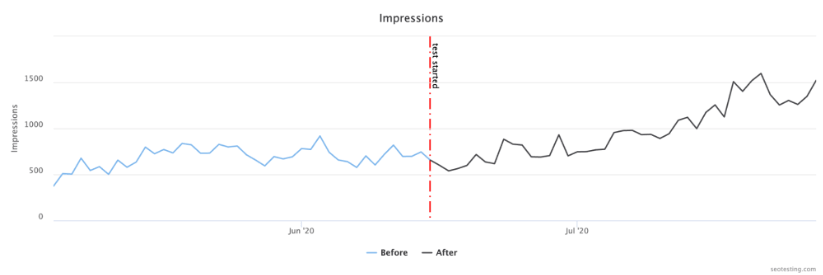
The above screenshot shows the impact on impressions following the content refresh.
This content refresh resulted in the following:
- An increase of 524% in organic clicks.
- A 42% increase in impressions.
- The CTR of the article increased from 0.3% to 1.32%, A 340% increase.
Content refreshes should generally be done every three months. This creates a good balance for most businesses between their ability to still get brand new content out on the web and updating older content to ensure it remains fresh and relevant to users. This timeline also takes into account any search intent changes that can happen during that time.
What is a Website Layout Update?
Website layout updates involve any change to your website that impacts the layout. A good example is when businesses update their homepage to help users navigate their website better.
A business’s previous homepage might have looked something like this:
- Hero navigation.
- Hero image.
- Introduction to the business.
- FAQs.
- Customer testimonials.
- Contact information.
And they might decide to move to something along these lines:
- Hero navigation.
- Introduction to the business.
- Key features.
- Customer testimonials.
- Contact information.
These types of decisions are usually made based on customer feedback, the results of tests completed on software such as CrazyEgg, which measures how users interact with a particular website, or based on intuition or small-scale SEO tests on other pages.
We’ve done this with the SEOTesting website a couple of times. Most notably on the SEOTesting pricing page. Previously, our pricing page looked like this:

Our previous pricing page interaction included information on pricing and very little else.
Whereas now, our pricing page looks like this:
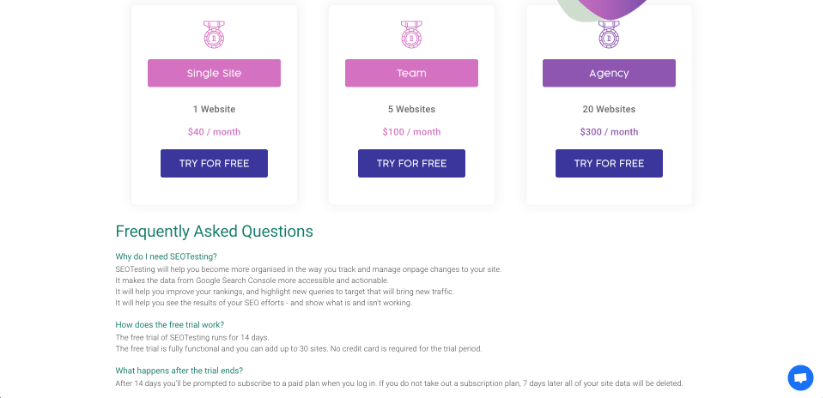
You can see from the image above we have added some FAQs underneath the pricing.
The most notable change is that we are including an FAQ section underneath our pricing information. We have had many conversations with customers over the years, and from this, we have come up with a list of questions we typically get from people who are interested in our software. What better way to increase trial sign-ups than to answer these questions on the page?
Website layout updates do not need to be completed as frequently as content refreshes, but businesses should still look to update the look and feel of their website every eighteen months to two years as a general rule of thumb. Unless, in the meantime, they notice competitors starting to refresh their site looks, and they begin to out-perform your business.
What is a CMS Migration?
A CMS migration is moving a website from one CMS to another. A great example would be moving your website from Shopify to WooCommerce (WordPress).
There are several reasons companies choose to do this:
- They want to make it easier for team members to change pages.
- Migrating CMS might lead to faster load times.
- The company may have been acquired, and the new holding company wants to switch.
- The business may have changed direction and needs to be able to sell online.
Whatever the reason, though, migrations are rare. They are a huge undertaking, require the input and output of many stakeholders, generally cost a lot of money, and there are always risks associated with migrating. If a migration is not done correctly, it can lead to disastrous results:

This is a screenshot from Google Analytics showing a site’s decline in traffic following a migration.
That all being said, when a CMS migration is done right, it can lead to excellent results in SEO and other areas of digital:
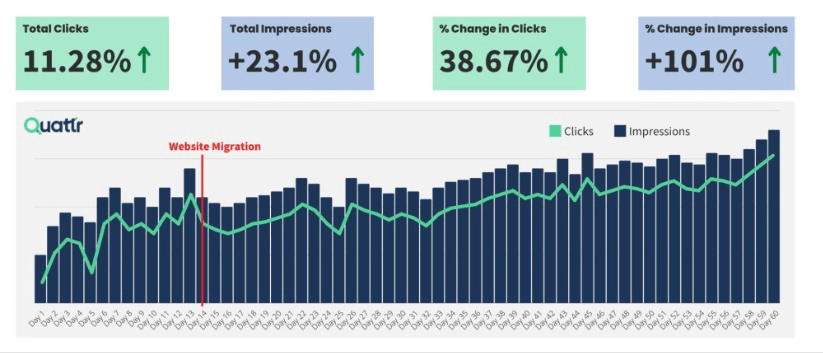
So when you, as a business, decide it is time to complete a CMS migration, you need to do it right. Remember, it is expected to see a temporary decline in traffic following any type of site migration as Google and other search engines work to re-crawl all of your pages. Still, the results (when done well) are often better than you could imagine.
There is no general rule of thumb to follow regarding the cadence at which you update your CMS. In general, this should be avoided unless the business opportunities of a CMS migration outweigh the risks. Suppose you notice your site falling behind in search results. In that case, your site speed might be taking a hit, or competitors might be outranking you even though your content is better. Consider a CMS migration.
What is a Website Redesign?
Website redesigns can be classed as any update involving a considerable change in how a website looks, feels, and how users interact with the site. One of my favorite examples is from Rev:
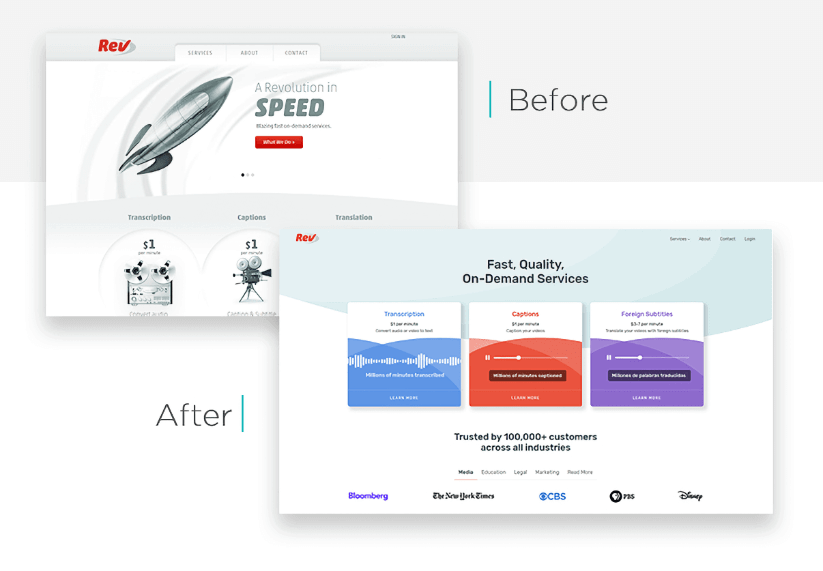
As you can see, they made the website much more straightforward to navigate, and now it is easy for customers (and potential customers) to see what they do and how they can help.
Taking on a website redesign is challenging and, for some, daunting. It requires a lot of input from various stakeholders, including management, designers, developers, marketers, and, in some cases, even data science teams, depending on the company’s size.
With that in mind, you need to make sure that you need a website redesign before you decide to take one on. Much like a CMS migration, there are risks associated with Google re-crawling and re-indexing content once it has been completed. In most cases, you will see a small traffic drop followed by traffic returning to normal levels or increasing if Google ‘likes’ your website update.
Again, there is no required cadence for a website redesign, but you may want to consider updating how your website looks and feels every two years or so. This timeframe allows you to gather lots of data about how users interact with your website and how competitors are doing compared to your performance. It will also allow you to change your website as new web design strategies become popular.
Why are Content Updates Important?
Content updates play a vital role in keeping websites fresh and engaging, both for search engine crawlers and (more importantly) users. When done well, they attract new visitors and help retain existing users by providing them with current and relevant information.
Let’s say, for example, that you complete a content refresh, and it does well. This will lead to more visibility in search engines, which, in turn, will lead to higher levels of organic traffic and user engagement.
Furthermore, updating content regularly will signal to both users and search engines that your website is active and well-maintained. This will help you enhance your website’s credibility and authority in its niche.
Generally, content updates (however significant) are essential for staying competitive and relevant. But there are more nuanced reasons that you should also pay attention to.
Stay Ahead of the Competition
Staying ahead of the competition is vital to succeeding in the SERPs. One of the best ways to do this is by regularly updating your website’s content.
Let’s take a look at the ‘position history’ from Ahrefs of the keyword sneakers:
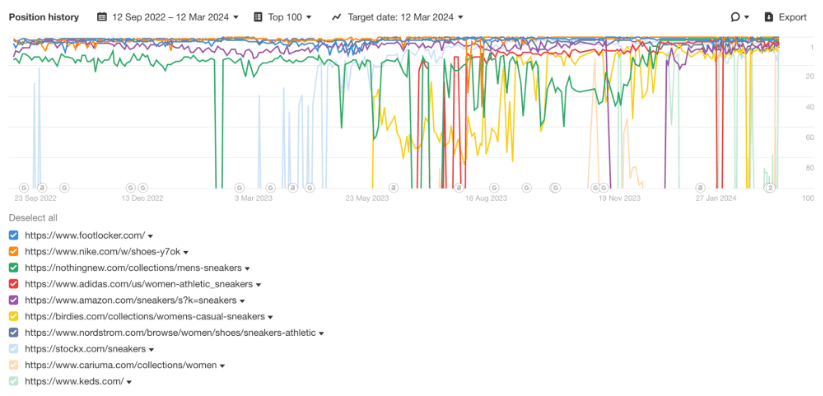
As you can see, there is a lot of competition for the top spots for this keyword. However, it is generally two websites competing for the top spot most of the time. Footlocker and Nike.
If we head to Wayback Machine and establish how often these pages are updated, we get our answer:

This is the number of times Wayback Machine crawled Footlocker’s page. We can see many updates here, especially implemented redirects, which are shown in green.
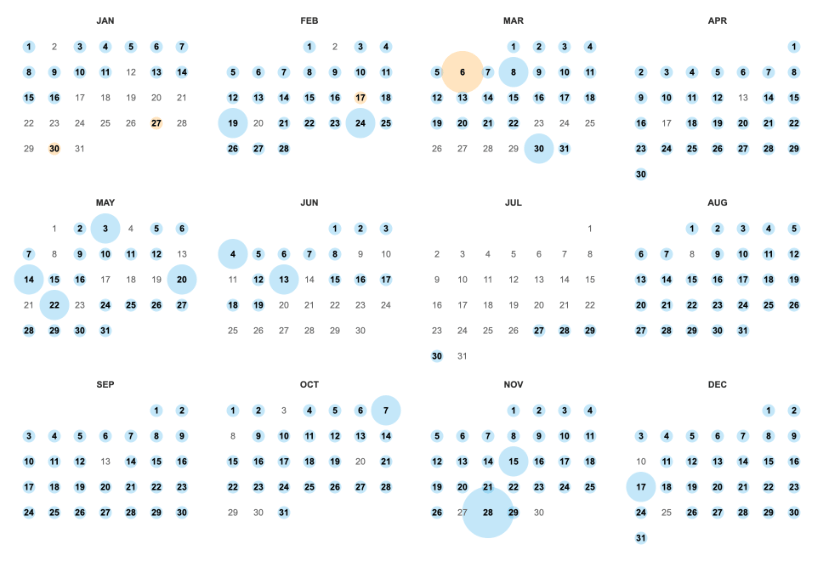
The above screenshot shows Nike’s page for 2023. We can see the content on the page was crawled by Wayback Machine many times over the year, but far fewer redirects were implemented. We can also see that the content was not crawled as much, indicating that this might be because the content was not updated as much.
It’s not just pages ranking for these prominent, high-traffic keywords either. Here’s an image showing how many times we have updated our article on SEO testing over the years:
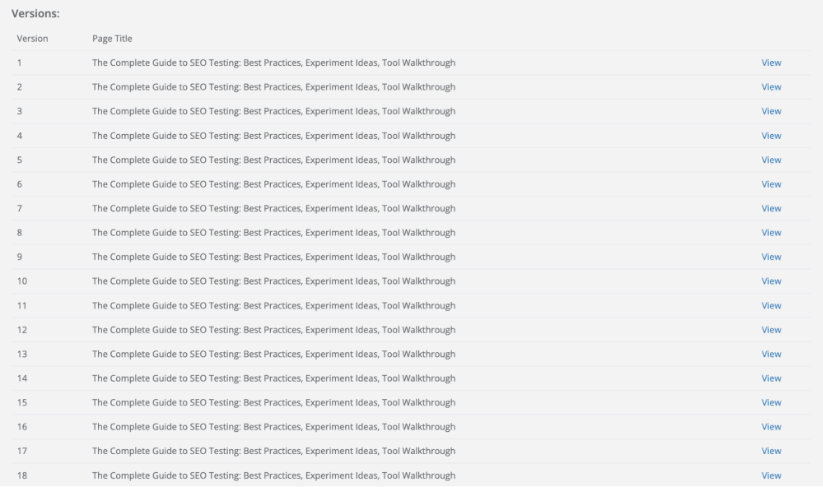
This article has been updated on 51 occasions since it was first published.
This works. Through the regular refreshing of our content, we can get a steady stream of traffic through to our page via lots of different search queries:
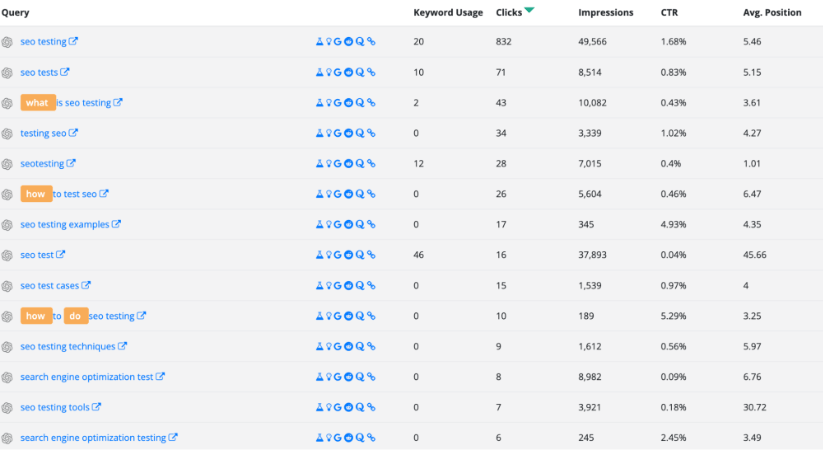

Ensures your Content Remains Fresh
Freshness is a ranking factor. We know that. But Google determines freshness in several different ways:
- It looks at when the page was first published.
- It looks at the number of changes to the page when it is updated.
- It looks at the number of times the content has been updated overall.
- It looks at the freshness of backlinks to the page.
It has been looking at this since the freshness update of 2011, so this is not new. But we know that regularly updating our content gives it the best chance of ranking well in the SERPs. Through regular updates, we can ensure we constantly match the search intent for different search queries, we can ensure our content remains better than competing content, and we can ensure that Google knows our website is highly active in updating older content, keeping it fresh, and ensuring we remain as authoritative as possible.
Improves your SEO Skills
Regularly updating your content is essential in helping you improve your SEO skills by providing opportunities for continuous improvement through hands-on experience. With each content update that you do, you get to experiment with different SEO techniques, such as:
- Keyword optimization.
- Meta tag writing/optimizing.
- Internal linking strategies.
- General content writing.
This information gives you direct insights into what works best to enhance your website’s visibility in the SERPs.
Moreover, content updates require you to analyze different performance metrics, such as page views, engagement rates, and time spent on the site, which will help you understand the impact of your various SEO efforts. Doing this kind of analysis regularly not only sharpens your ability to interpret data but will also help you refine strategies in the future for better results.
Measuring the Results of Content Updates
Once you have completed a content update, whatever the update is, it’s also crucial to measure the results that come from these updates so your business can continue growing online as it should.
One of the best ways to do this is using time-based SEO tests. These tests measure page performance from a set time period before the update went live and the same time period following the update. This allows you to measure what has happened to the page since the update and whether the work is worth repeating on other low-performing pages.
Using SEO tests in this way will allow you to measure, over time, what types of updates work for what content on your site—making improving page performance a more straightforward task than if you were working without data. You can then use the results of smaller-scale SEO tests to get a budget for even more content updates in the future. This is an excellent way for SEOs and other marketing professionals to show what works and get recognition.
Wrapping Things Up
In conclusion, regularly updating your website’s content cannot be overstated for businesses keen to thrive in the digital landscape. Whether you’re part of a SaaS, e-commerce, or any online venture, refreshing your content every three months as a minimum (in most cases) should be part of your SEO strategy. This ensures your website remains relevant, competitive, and aligned with users’ and search engines’ constantly evolving demands.
From minor tweaks in internal links to comprehensive website overhauls, each update is crucial in enhancing user engagement, improving organic traffic, and maintaining your site’s freshness. Furthermore, regular updates provide invaluable opportunities to refine your SEO skills through hands-on experience and performance analysis. By employing tools like the Content Decay Report or conducting thorough manual audits, you can efficiently identify areas needing attention, ensuring your website remains a dynamic, engaging, and authoritative presence online.
Remember, staying static is not an option in the fast-paced world of SEO. Embrace the continuous cycle of content updates to secure and enhance your online visibility and success.
Interested in seeing, in more detail, how we use GSC data to make it more advantageous for you? Take a look at SEOTesting! We offer a wide range of options for SEO testing and create handy reports based on your website’s GSC data to help you make more data-driven decisions in less time. Sign up for our 14-day free trial today.

